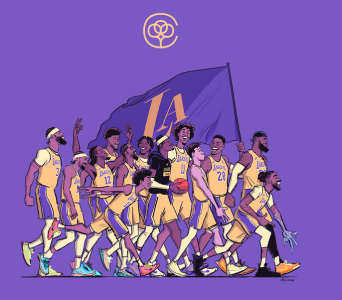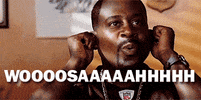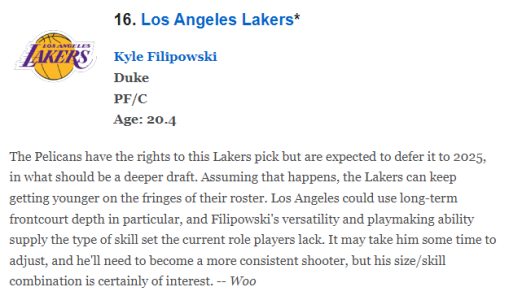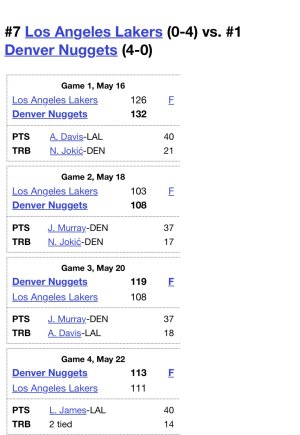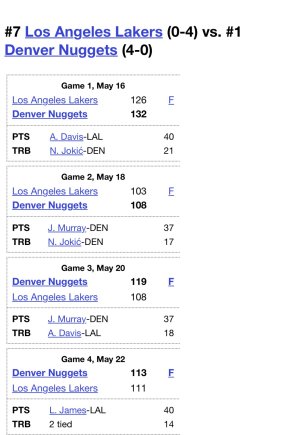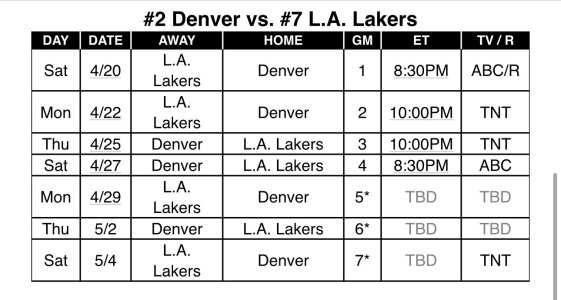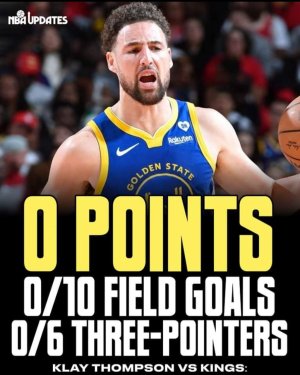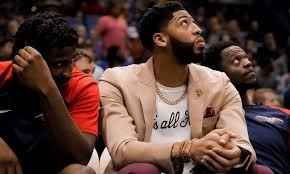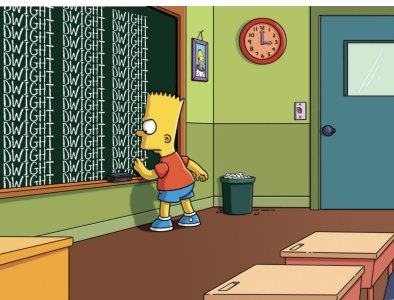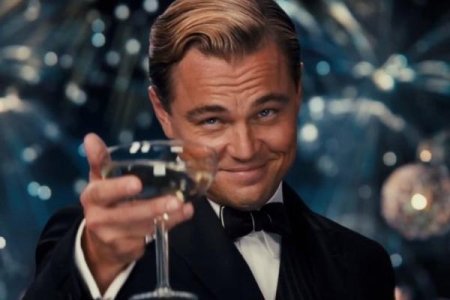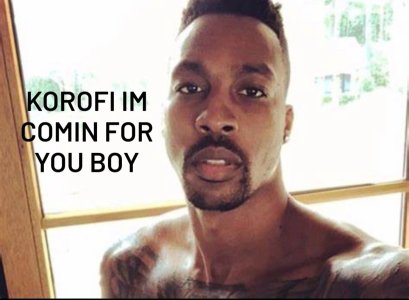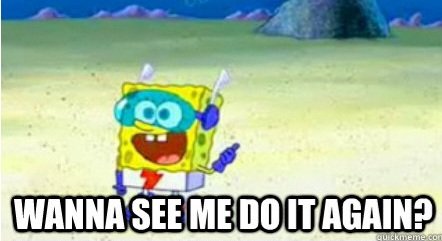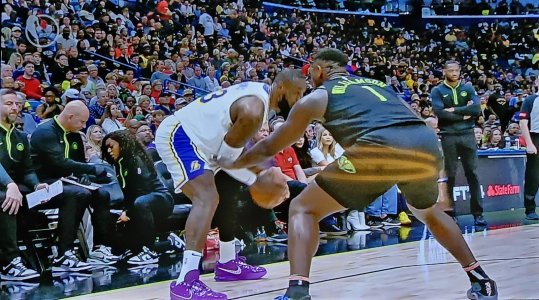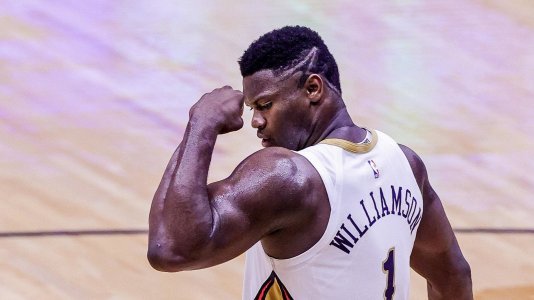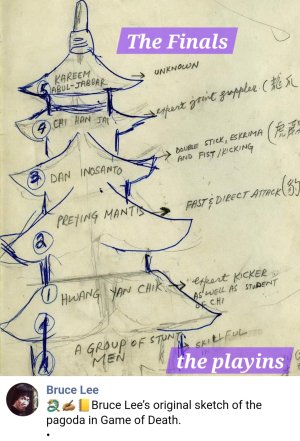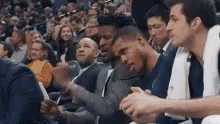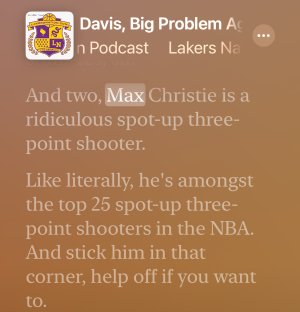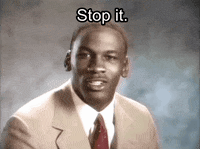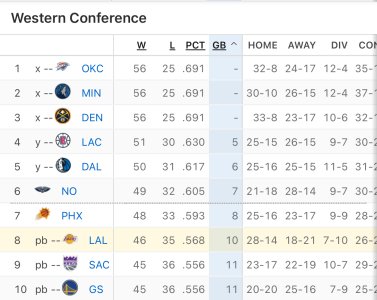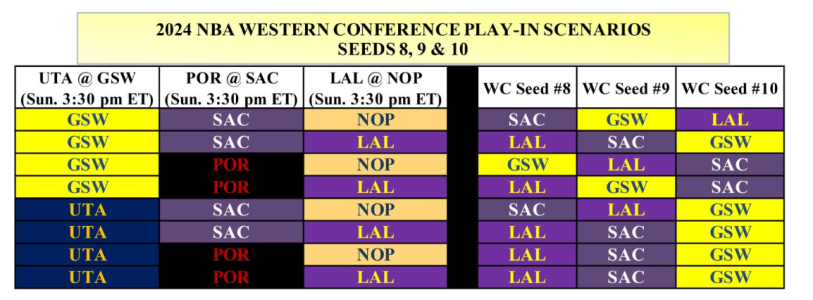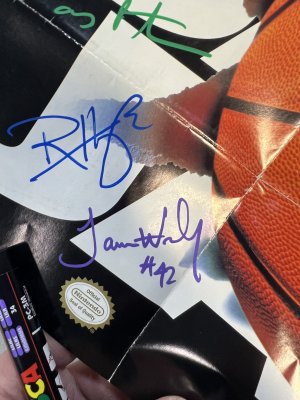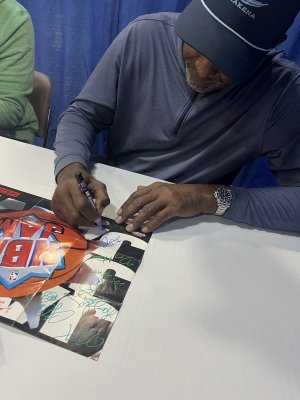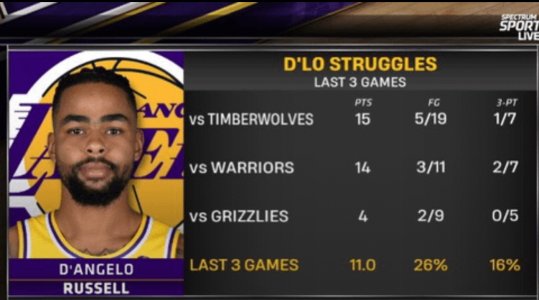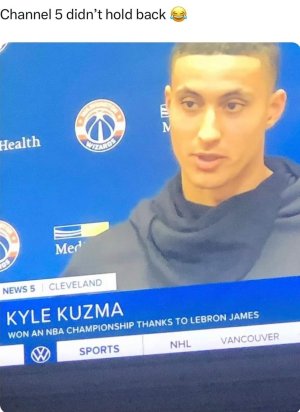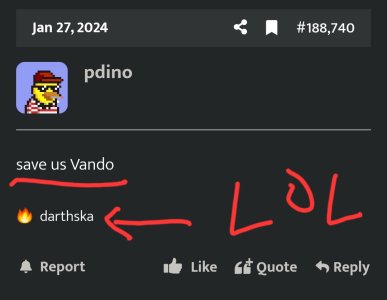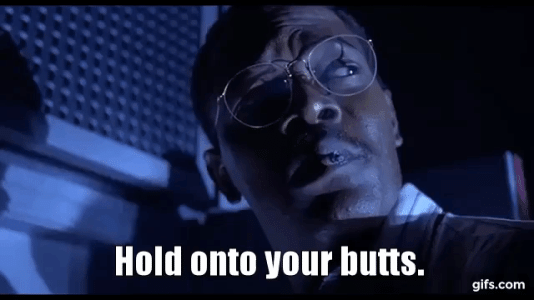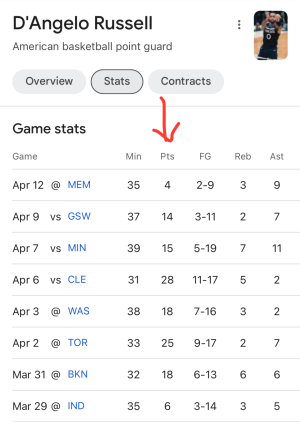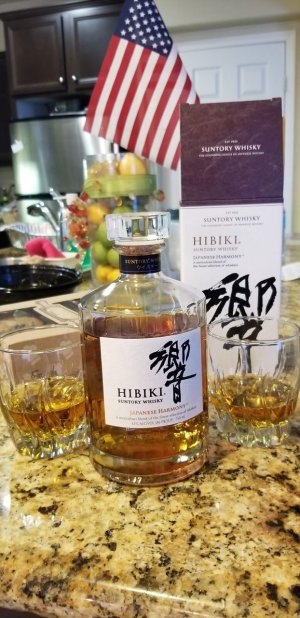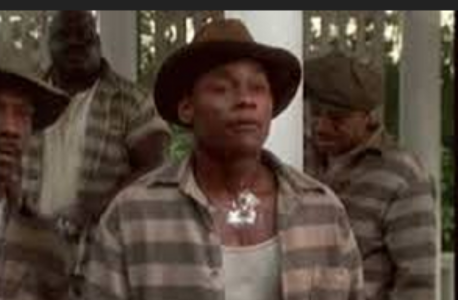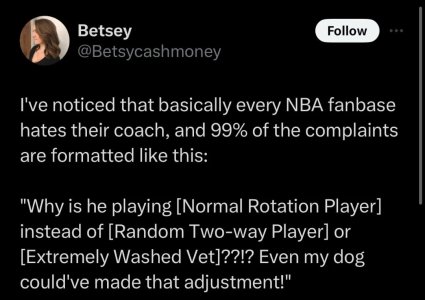Navigation
Install the app
How to install the app on iOS
Follow along with the video below to see how to install our site as a web app on your home screen.

Note: this_feature_currently_requires_accessing_site_using_safari
More options
You are using an out of date browser. It may not display this or other websites correctly.
You should upgrade or use an alternative browser.
You should upgrade or use an alternative browser.
**LA LAKERS THREAD** Sitting on 17! 2023-2024 offseason begins
- Thread in 'Sports & Training' Thread starter Started by licensed to ball,
- Start date
darthska
Staff member
- 43,735
- 27,277
- Joined
- Apr 30, 2004
It's almost like... if you have a healthy roster... and a decent coach... you... I don't know... maybe... go to the Finals.Missed the playoffs the last two years.
In the Finals this year.....even won playoff games from his couch.
Really worked that dry erase board this season.
Really crushed those 10 AM walkthrus.
Because there are droves of examples of stellar rosters that didn't even sniff the Finals, and on the flipside there are examples of widely respected coaches that didn't have healthy rosters and came up short. But you have a widely respected coach and a healthy roster... hmmm...
-foe
It's almost like... if you have a healthy roster... and a decent coach... you... I don't know... maybe... go to the Finals.
Because there are droves of examples of stellar rosters that didn't even sniff the Finals, and on the flipside there are examples of widely respected coaches that didn't have healthy rosters and came up short. But you have a widely respected coach and a healthy roster... hmmm...
-foe
Or even a rookie coach.....

darthska
Staff member
- 43,735
- 27,277
- Joined
- Apr 30, 2004
Wait so you can't be stellar and a rookie? If you experience great success your 1st season and people credit it to you, everyone has to be wrong because you're a rookie?Or even a rookie coach.....
Magic, your thoughts?
Dog its ALL PIECES. Jesus ****...
-foe
Wait so you can't be stellar and a rookie? If you experience great success your 1st season and people credit it to you, everyone has to be wrong because you're a rookie?
Magic, your thoughts?
Dog its ALL PIECES. Jesus ****...
-foe
Rookie PLAYER, lot diff impact than rookie COACH.
Player actually does **** on the court. Rookie coach ain't puttin up 42 in a game 6 without their #1.
- 22,065
- 15,979
- Joined
- Jul 16, 2017
- 15,115
- 16,131
- Joined
- Feb 17, 2019
Thr only thing Boston is winning is an early trip to Disneyland like Yanni.Where’s the dudes who said no way Boston has a chance to win the chip? It’s lookin scary now
If they win #18, Jeanie deserves it
Warriors with home court too? Dubs in 6
- 18,255
- 12,562
- Joined
- Apr 24, 2006
Coach talk again?

- 15,115
- 16,131
- Joined
- Feb 17, 2019
If coaches didn't matter, Rich Paul would be holding that clipboard on the Lakers' sideline with Adele as his top assistant.
- 21,984
- 23,904
- Joined
- Feb 23, 2010
Rob saying "they prob thinking we did everything we needed to beat this team and they still come out on top" over the video clip of CWebb and Vlade looking befuddled walking into the tunnel is hilarious
- 15,115
- 16,131
- Joined
- Feb 17, 2019
Rob saying "they prob thinking we did everything we needed to beat this team and they still come out on top" over the video clip of CWebb and Vlade looking befuddled walking into the tunnel is hilarious
7 rings. 2-way player deluxe. Could start or come off the bench and impact the game either way. Clutch is an understatement.
He could slash to the basket, hit threes, hit mid range jumpers, rebound, block shots, Defend the wing, Defend the paint, defend the post, what else couldn't he do? He rarely made mistakes in key moments of the game. Ntm he was the perfect locker room guy. More importantly, he came to play every night.
Career 7 ppg scorer yet he is...
THE undisputed
G greatest
R oleman
O f
A ll
T ime
Last edited:
- 6,594
- 9,126
- Joined
- Sep 19, 2012
I keep hearing people complain about how the Lakers are taking forever to sign a coach but has any team with an opening hired anyone yet? I honestly haven’t been paying attention
- 41,753
- 175,196
- Joined
- Oct 28, 2013
- 85,446
- 111,493
- Joined
- Sep 5, 2010
The Kings hired Mike Brown.I keep hearing people complain about how the Lakers are taking forever to sign a coach but has any team with an opening hired anyone yet? I honestly haven’t been paying attention
- 6,594
- 9,126
- Joined
- Sep 19, 2012
I meant like serious basketball teamsThe Kings hired Mike Brown.
- 85,446
- 111,493
- Joined
- Sep 5, 2010
A little smaller than I would prefer (6'4ish), but he's the quintessential 3 & D player. Would be a good gamble in the second round, or navigate to get undrafted a la Reaves.
- 22,065
- 15,979
- Joined
- Jul 16, 2017
- 85,446
- 111,493
- Joined
- Sep 5, 2010
A little smaller than I would prefer (6'4ish), but he's the quintessential 3 & D player. Would be a good gamble in the second round, or navigate to get undrafted a la Reaves.
- 85,446
- 111,493
- Joined
- Sep 5, 2010
The Shaq-Kobe-Fish Era ended so abruptly that you forget they won 20 playoff series in eight trips to the playoffs.
- 85,446
- 111,493
- Joined
- Sep 5, 2010
- 85,446
- 111,493
- Joined
- Sep 5, 2010
Three things the Lakers can learn from the 2022 NBA postseason
On April 22, LeBron James tweeted a sentiment that many Los Angeles Lakers fans watching postseason basketball on their couches could relate to.
For James’ tweet to come to fruition and the Lakers to return to the playoffs next season, they need to treat this season as a learning lesson. That includes the postseason, which is the ultimate basketball litmus test, often revealing the way the game has evolved and the way teams will build their rosters and strategize in upcoming seasons.
The Lakers have several important offseason decisions — the next head coach, Russell Westbrook’s future, free agency — that are somewhat out of their control. But here are three lessons from the playoffs that they can implement regardless of how the summer plays out.
Centers are less valuable in a 16-game setting
Height and length will always matter in a game with a 10-foot basket. If a team could find and play five Giannis Antetokounmpos, it would. There’s a reason we haven’t seen a team play five guards. You still have to rebound and protect the rim — especially as legs and lungs get tired and shots start to fall short, leading to more rebounding opportunities.
But three of the four teams in both conference finals don’t have a player taller than 6-foot-9 in their primary rotation (Golden State Warriors, Boston Celtics and Miami Heat). Dallas has three players listed at 6-foot-10, but two of them are perimeter-oriented (Maxi Kleber and Dāvis Bertāns). Dwight Powell is the only “traditional” big, and even then, he’s a mobile rim runner.
In previous rounds, bigs like Rudy Gobert, Deandre Ayton and Brook Lopez — all good players — were somewhat spread thin against five-out offenses that forced them into perimeter rotations and defending wings and guards at the 3-point line. In contrast, the surviving bigs are more mobile, capable of rim running and/or popping out and spacing the floor, and switching out on the perimeter (or, at least, holding their own against perimeter ballhandlers).
The Lakers have an outlier in Anthony Davis who can do all of those things — recent shaky jump shot aside — in the frame of a 6-foot-11 player. It’s one of the reasons he’s a unicorn and still so valuable. He’s the ultimate small-ball cheat code (along with Antetokounmpo, Bam Adebayo, Draymond Green and a few others), allowing the Lakers to retain the spirit of a small-ball unit while he uses his size, length and speed to dominate against smaller opponents.
Though it’ll be difficult for the Lakers to find a bunch of versatile bigs for cheap, they can use their 2020 team as a solid blueprint. The big rotation of James, Davis, Kyle Kuzma, Markieff Morris, JaVale McGee and Dwight Howard was flexible enough to handle basically any opponent’s style. James and Davis are James and Davis. Kuzma and Morris were mobile enough to defend multiple positions, including smaller wings. McGee and Howard could rim-run and protect the paint on the other end.
The 2021 group was still solid but less flexible. Marc Gasol could pass and space the floor but was limited defensively in certain matchups against quicker guards. Andre Drummond could move his feet reasonably well but was a negative floor spacer. Montrezl Harrell has proven to be an 82-game player rather than a 16-game player. Morris and Kuzma remained but weren’t as effective. James and Davis combined to miss over 60 games.
This past season, though, the Lakers took a considerable step back with their big rotation. Davis missed more than half of the season. James missed more than a third of the games. DeAndre Jordan wasn’t playable, Howard regressed to an every-other-night backup, and the Lakers were lacking in wing-sized players. Carmelo Anthony regressed as a shooter in the second half of the season and was a defensive liability. Trevor Ariza was a shell of himself and was eventually waived. Stanley Johnson and Wenyen Gabriel joined the team too late and were often outmatched against bigger, more physical opponents.
As the Lakers fill out their frontcourt, particularly their center/big rotation, they should aim for more players in the Kuzma/Morris mold rather than the McGee/Howard mold. They’ll need a hulking backup, as every team does, but they need more shooting and versatility at the four and five spots.
Perimeter versatility continues to increase in importance
Consequently, perimeter size, versatility and switchability have never been more important qualities to have on the roster.
Just look at the best players in the conference finals: They’re all either perimeter players or have the skills of perimeter players (Adebayo, Green and Al Horford). There are some exceptions — Robert Williams and Kevon Looney — but they’re at least mobile, defensively, and they’re not stars.
As teams advance in the postseason, they need to deploy some form of switching, albeit all five players or only three or four. The more versatile a defense is, the greater its room for error — errors that can, obviously, compound to determine a playoff game and, to a larger extent, a series.
It’s the present and future of the NBA. Next season, teams like the Celtics, Warriors, Mavericks, Heat and LA Clippers — who will be adding a healthy Kawhi Leonard to an army of wings — will be atop the league once again. The Lakers will have to find ways to match up with those teams when they shift to five-out lineups.
The Lakers have an advantage in that Davis and James almost always have a physical advantage, regardless of the position they’re playing. But that’s especially true when they’re at center and power forward, respectively, in smaller lineups. The Lakers need to find the right supporting pieces — including at least a couple of reliable 3-and-D wings — to fill out closing lineups against the league’s elite.
With the taxpayer midlevel exception ($6.3 million) as their primary tool to improve the roster in free agency, the Lakers should look to use their movable assets —Russell Westbrook, Talen Horton-Tucker, Kendrick Nunn and/or their 2027 and 2029 first-round picks — to get as many useful two-way players in the 6-foot-6 to 6-foot-9 range as they can.
3-point frequency is a key offensive factor
All four conference finalists ranked in the top 10 in 3-point frequency (percentage of shots that are 3-point attempts). Three of the teams were in the top eight; two were in the top five. In the postseason, all four teams rank in the top seven.
This isn’t to say that 3-point frequency is everything, but in recent years, it has been one of the offensive factors that have correlated with postseason success. It’s even more important than 3-point makes or 3-point percentages, as it tends to reflect the type of offense a team is running, though frequency, makes and percentage all can go hand in hand. (It’s also worth noting three of the four teams rank in the top four of 3-point makes per game and the top six of 3-point percentage.)
There always will be a limit to how much a James- and Davis-led offense shoots 3s. With those two on the floor, the Lakers should prioritize points in the paint and shots at the rim. But part of the beauty of having both superstars — one a legendary passer and one an underrated passer — is that they can generate open 3-point looks for teammates at a high rate.
Here is a table of the Lakers’ 3-point frequency and leaguewide rank, year over year, in the James-Davis era.

The Lakers’ 3-point frequency is heading in the right direction, slowly but surely. The last time the Lakers ranked in the top 15 in 3-point frequency was 2015-16, Kobe Bryant’s final season.
It’s no secret how important 3-point shooting has become. It’s becoming increasingly difficult to lose the 3-point battle and still win in 2022. The Lakers need better shooters and a coach who will prioritize creating 3-point looks at a greater level.
On April 22, LeBron James tweeted a sentiment that many Los Angeles Lakers fans watching postseason basketball on their couches could relate to.
For James’ tweet to come to fruition and the Lakers to return to the playoffs next season, they need to treat this season as a learning lesson. That includes the postseason, which is the ultimate basketball litmus test, often revealing the way the game has evolved and the way teams will build their rosters and strategize in upcoming seasons.
The Lakers have several important offseason decisions — the next head coach, Russell Westbrook’s future, free agency — that are somewhat out of their control. But here are three lessons from the playoffs that they can implement regardless of how the summer plays out.
Centers are less valuable in a 16-game setting
Height and length will always matter in a game with a 10-foot basket. If a team could find and play five Giannis Antetokounmpos, it would. There’s a reason we haven’t seen a team play five guards. You still have to rebound and protect the rim — especially as legs and lungs get tired and shots start to fall short, leading to more rebounding opportunities.
But three of the four teams in both conference finals don’t have a player taller than 6-foot-9 in their primary rotation (Golden State Warriors, Boston Celtics and Miami Heat). Dallas has three players listed at 6-foot-10, but two of them are perimeter-oriented (Maxi Kleber and Dāvis Bertāns). Dwight Powell is the only “traditional” big, and even then, he’s a mobile rim runner.
In previous rounds, bigs like Rudy Gobert, Deandre Ayton and Brook Lopez — all good players — were somewhat spread thin against five-out offenses that forced them into perimeter rotations and defending wings and guards at the 3-point line. In contrast, the surviving bigs are more mobile, capable of rim running and/or popping out and spacing the floor, and switching out on the perimeter (or, at least, holding their own against perimeter ballhandlers).
The Lakers have an outlier in Anthony Davis who can do all of those things — recent shaky jump shot aside — in the frame of a 6-foot-11 player. It’s one of the reasons he’s a unicorn and still so valuable. He’s the ultimate small-ball cheat code (along with Antetokounmpo, Bam Adebayo, Draymond Green and a few others), allowing the Lakers to retain the spirit of a small-ball unit while he uses his size, length and speed to dominate against smaller opponents.
Though it’ll be difficult for the Lakers to find a bunch of versatile bigs for cheap, they can use their 2020 team as a solid blueprint. The big rotation of James, Davis, Kyle Kuzma, Markieff Morris, JaVale McGee and Dwight Howard was flexible enough to handle basically any opponent’s style. James and Davis are James and Davis. Kuzma and Morris were mobile enough to defend multiple positions, including smaller wings. McGee and Howard could rim-run and protect the paint on the other end.
The 2021 group was still solid but less flexible. Marc Gasol could pass and space the floor but was limited defensively in certain matchups against quicker guards. Andre Drummond could move his feet reasonably well but was a negative floor spacer. Montrezl Harrell has proven to be an 82-game player rather than a 16-game player. Morris and Kuzma remained but weren’t as effective. James and Davis combined to miss over 60 games.
This past season, though, the Lakers took a considerable step back with their big rotation. Davis missed more than half of the season. James missed more than a third of the games. DeAndre Jordan wasn’t playable, Howard regressed to an every-other-night backup, and the Lakers were lacking in wing-sized players. Carmelo Anthony regressed as a shooter in the second half of the season and was a defensive liability. Trevor Ariza was a shell of himself and was eventually waived. Stanley Johnson and Wenyen Gabriel joined the team too late and were often outmatched against bigger, more physical opponents.
As the Lakers fill out their frontcourt, particularly their center/big rotation, they should aim for more players in the Kuzma/Morris mold rather than the McGee/Howard mold. They’ll need a hulking backup, as every team does, but they need more shooting and versatility at the four and five spots.
Perimeter versatility continues to increase in importance
Consequently, perimeter size, versatility and switchability have never been more important qualities to have on the roster.
Just look at the best players in the conference finals: They’re all either perimeter players or have the skills of perimeter players (Adebayo, Green and Al Horford). There are some exceptions — Robert Williams and Kevon Looney — but they’re at least mobile, defensively, and they’re not stars.
As teams advance in the postseason, they need to deploy some form of switching, albeit all five players or only three or four. The more versatile a defense is, the greater its room for error — errors that can, obviously, compound to determine a playoff game and, to a larger extent, a series.
It’s the present and future of the NBA. Next season, teams like the Celtics, Warriors, Mavericks, Heat and LA Clippers — who will be adding a healthy Kawhi Leonard to an army of wings — will be atop the league once again. The Lakers will have to find ways to match up with those teams when they shift to five-out lineups.
The Lakers have an advantage in that Davis and James almost always have a physical advantage, regardless of the position they’re playing. But that’s especially true when they’re at center and power forward, respectively, in smaller lineups. The Lakers need to find the right supporting pieces — including at least a couple of reliable 3-and-D wings — to fill out closing lineups against the league’s elite.
With the taxpayer midlevel exception ($6.3 million) as their primary tool to improve the roster in free agency, the Lakers should look to use their movable assets —Russell Westbrook, Talen Horton-Tucker, Kendrick Nunn and/or their 2027 and 2029 first-round picks — to get as many useful two-way players in the 6-foot-6 to 6-foot-9 range as they can.
3-point frequency is a key offensive factor
All four conference finalists ranked in the top 10 in 3-point frequency (percentage of shots that are 3-point attempts). Three of the teams were in the top eight; two were in the top five. In the postseason, all four teams rank in the top seven.
This isn’t to say that 3-point frequency is everything, but in recent years, it has been one of the offensive factors that have correlated with postseason success. It’s even more important than 3-point makes or 3-point percentages, as it tends to reflect the type of offense a team is running, though frequency, makes and percentage all can go hand in hand. (It’s also worth noting three of the four teams rank in the top four of 3-point makes per game and the top six of 3-point percentage.)
There always will be a limit to how much a James- and Davis-led offense shoots 3s. With those two on the floor, the Lakers should prioritize points in the paint and shots at the rim. But part of the beauty of having both superstars — one a legendary passer and one an underrated passer — is that they can generate open 3-point looks for teammates at a high rate.
Here is a table of the Lakers’ 3-point frequency and leaguewide rank, year over year, in the James-Davis era.
The Lakers’ 3-point frequency is heading in the right direction, slowly but surely. The last time the Lakers ranked in the top 15 in 3-point frequency was 2015-16, Kobe Bryant’s final season.
It’s no secret how important 3-point shooting has become. It’s becoming increasingly difficult to lose the 3-point battle and still win in 2022. The Lakers need better shooters and a coach who will prioritize creating 3-point looks at a greater level.
Should be interesting to monitor.
- 87,991
- 46,882
- Joined
- Feb 29, 2000
can learn how to keep ad from getting injured. thats the main block keeping them from being contenders.
- 85,446
- 111,493
- Joined
- Sep 5, 2010
- 22,065
- 15,979
- Joined
- Jul 16, 2017
- 6,594
- 9,126
- Joined
- Sep 19, 2012
In the case of Baze this is exactly the kind of thing that we fans are asking free agents to do (take less money to play for Lakers) but when it doesn’t work out some of those same fans want to clown the player in hindsight?
Alrighty then…
Alrighty then…
Last edited:
Similar threads
- Replies
- 6
- Views
- 2K
- Replies
- 38K
- Views
- 2M

